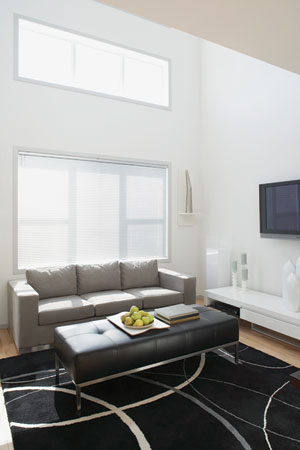Acoustical Control with Gypsum Board
ACOUSTICS IN THE INTERNATIONAL GREEN
CONSTRUCTION CODE (IGCC)
The International Green Construction Code (IgCC) is a comprehensive code released in 2012 by the International Code Council (ICC) for adoption by jurisdictions around the country. The IgCC is the first model code that includes sustainability measures for an entire design and construction project and its site. This new code is expected to make buildings more energy and material efficient, reduce waste, and have a positive impact on the health, safety and welfare of building occupants and the community. By creating a regulatory framework for new and existing buildings it establishes minimum green requirements for buildings and complementary voluntary rating systems. The code acts as an overlay to the existing set of International codes authored and distributed by the ICC. Acoustics are specifically addressed in the IgCC in Section 807 and focus on a variety of conditions and elements that are similar to other standards. Where the local code authorities have indicated that Section 807 is enforceable, the sound transmission levels must be limited in accordance with the STC / IIC criteria provided for specific areas of the building as follows:
- Interior Sound Transmission: The code addresses separation between tenants or different occupancies in a building as identified in the International Building Code. For example, wall and floor/ ceiling assemblies that separate Group A (Assembly) and F (Factory) occupancies from one another or between Group B (Business), I (Institutional), M (Mercantile) or R (Residential) occupancies must achieve an STC rating of not less than 60. It also allows for field testing as an alternative to factory testing, but adjusts the requirement by referring to it as an Apparent Sound Transmission Class (ASTC) rating and requiring a value of not less than 55 in this case. Wall and floor/ceiling assemblies that separate Group B, I, M or R occupancies from one another shall have an a less restrictive STC rating of not less than 50 or an ASTC of not less than 45 if the completed construction is field tested. These ratings increase if a Group R condominium occupancy is involved to an STC of 55 or and ASTC of 50.
-
Background Sound Levels: Sound generated from mechanical and electrical equipment must be isolated in rooms where the walls and floor/ceiling assemblies achieve a minimum STC rating of 50 (or ASTC of 45). Rooms that contain emergency generators must achieve an STC rating of 60 (or ASTC of 55) although electrical generators used only for emergencies are exempt from limits on sound levels. The overall intent of this isolation is to produce background noise levels in adjacent rooms that do not create a detrimental acoustical interior environment. Accordingly, the code establishes maximum noise criteria (NC) limits, measured in decibels, both for outdoor spaces and for different types of rooms within a building. Generally, these limits fall within the faint to moderate levels of background noise thus establishing a minimum threshold for acoustical code compliance.
Good acoustical design is specifically addressed in dwelling units in the International Green Construction Code.
Photo courtesy of CertainTeed Gypsum
- Structure Borne Sound: The code addresses structure borne sound specifically as it applies to floor and ceiling assemblies in dwelling rooms or dwelling units. Hence any dwelling rooms or dwelling units that share a floor or ceiling assembly with another dwelling room or unit or with a public or service area within the structure must achieve an IIC rating of not less than 50 where laboratory tested and 45 where field-tested in accordance with ASTM E 492. Note that this requirement applies to dwelling rooms or units in building occupancies classified as Group Al, A2, A3, B, E, I, M or R.
- Special Inspections: In order to verify that the acoustical performance called for under the IgCC is achieved, an approved agency, funded by the building owner, must furnish report(s) of test findings indicating that the sound level results are in compliance with section 807 of the code and the construction documents. Discrepancies must be brought to the attention of the design professional and to the code official prior to the completion of work.
SUSTAINABLE MATERIAL CHOICES FOR ACOUSTICAL TREATMENTS
Sustainability and green principles are clearly important in all material selections, particularly if LEED® for Schools or Healthcare is being pursued. It is also important in other settings as well such as multi-family housing or general building construction. Clearly, maintaining the integrity of the green principles of the building means addressing all of the materials in the building, including the acoustical treatments. Therefore, beyond the acoustic qualities, the following should be considered:
- Selecting materials with recycled content. Acoustical treatments do not need to be manufactured from virgin raw materials. In fact noise reducing gypsum board will often have recycled content. It is possible and quite desirable to specify the face and back paper used for boards consisting of up to 100% recycled paper. Additionally, synthetic or “by-product” or DSG gypsum produced from the desulphurization of flue gases at coal-fired power plants is used where sources are available. The total recycled content for these synthetic gypsum plants is up to 96%. And most manufacturers assure that in-plant scrap is recycled back into the process.
- Reducing construction waste. Materials that are easy to work with and can be readily installed into the building should produce less waste. Converting to single layer noise reducing gypsum board instead of double layer traditional gypsum board means that less material is being used and less waste is generated.
- Selecting regional materials. This item is obviously dependent on the location of the building and the source of materials so it will not be possible for all projects. Nonetheless, gypsum board manufacturing locations provide regional material coverage throughout North America and should be eligible for regional materials in many locations.
- Indoor environmental quality contributions. We have been covering the acoustical qualities in some detail, but there are other considerations to take into account with noise reducing gypsum board. Specifically, moisture and mold resistant face and back paper also contribute to indoor air quality by providing enhanced moisture and mold resistance.
- Innovation in green design. Using some of the acoustic principles discussed previously, it is quite possible to exceed the stated minimums for acoustic performance and be recognized for innovation credit. It may also be possible to show the synergistic capabilities of noise reducing gypsum board in a particular building to demonstrate innovations in design.









